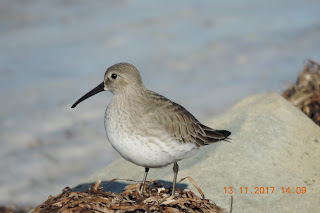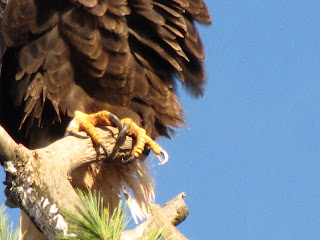NATURE
MONCTON INFORMATION LINE, November 17, 2017 (Friday)
Please advise editor at nelson@nb.sympatico.ca if any errors are noted in wording or
photo labeling.
For more information on Nature Moncton, check into the website at www.naturemoncton.com
For more information on Nature Moncton, check into the website at www.naturemoncton.com
Transcript by: Louise Nichols nicholsl@eastlink.ca
To respond by e-mail, please address
your message to the information line editor nelson@nb.sympatico.ca.
** Joyce Robinson reports the male SUMMER TANAGER [Tangara
vermillon] was
still in the Tormentine area on the cold day of Thursday; however, none of its
uncommon-to-New Brunswick friends could be located. One has to wonder if the upcoming warmer days
will bring them out again.
** Lisa Morris comments on the
behaviour of a subadult BALD EAGLE [Pygargue à tête blanche] as it patiently did a vigil from a tree
overlooking Jones Lake. The eagle was
very focused on the lake and possibly a gull carcass on the lake. The ducks on the water were totally
unconcerned. However, the gulls and the
geese that she had seen there earlier were nowhere to be seen.
** The EURASIAN COLLARED-DOVE
[Tourterelle turque] is
a bird originally introduced to the Bahamas and has expanded its range north
into the U.S. as well as parts of Canada, tending to be to the west of New
Brunswick. It will very likely become
part of New Brunswick’s wildlife soon and is easy to go unnoticed if mixing
with our very common MOURNING DOVE [Tourterelle triste] which itself is a pioneer to New
Brunswick in the past 25 years. When in
Florida recently, I was pleased to have a pair of Eurasian Collared-Doves come
close enough to photograph to realize that what I was seeing was an escapee
pair of RINGED TURTLE-DOVES [Tourterelle du cap]. The Ringed Turtle-Doves are very similar to
the Eurasian Collared- Doves and have appeared in the wild in New Brunswick,
but will not survive our winters. The
Eurasian Collared- Dove has visited New Brunswick only occasionally so far, so
still is on the “to add” list of most New Brunswick birders. A close look should easily pick up the
presence of a Eurasian Collared- Dove with its dark collar mark on the neck and
squared-off tail, not pointed as in the Mourning Dove. I was soon able to see lots of Eurasian
Collared- Doves in Florida and the basal black half of the under tail of the
Eurasian Collared- Dove easily differentiates it from an escapee Ringed Turtle-Dove. Be on the watch as I suspect this species
will be moving into New Brunswick sooner or later.
** This week’s Sky-at-a-Glance is included
in this edition, courtesy of Curt Nason.
This Week’s Sky at a Glance, November
18 – November 25
November is a time for mid-evening whale watching while the large
constellation of Cetus the Whale is well placed for viewing in the
southern sky. Many of its stars are not particularly bright so it can be
elusive, but you can piece it together in a fairly dark sky. The eastern
side of the square of Pegasus is a handy arrow that points down toward
Diphda, the brightest star in Cetus. Also called Deneb Kaitos, “the tail
of the whale,” it anchors a pentagram of stars forming the rear half of
Cetus below dim Pisces. A circlet of stars to the upper left, west of
Taurus, is the whale’s head.
A famous star in Cetus is Mira (circled in the diagram), perhaps the
first star to be recognized as a variable or one that changes its
brightness regularly. The name Mira translates as “wonderful.” It is a
red giant star that expands and contracts; brightening as it expands. At
minimum brightness it cannot be seen with binoculars, but every 11
months it brightens to easy naked eye visibility. The next maximum is
expected to be reached in late December. Midway on the western side of
the circlet of the whale’s head is a star that anchors an asterism which
resembles a question mark. Don’t ask why, just try it. A scope or
binoculars could reveal the galaxy M77 approximately midway between Mira
and Menkar, the star at the bottom of the circlet.
In mythology Cetus represents the sea monster created by Poseidon to
ravage the coastal area of Ethiopia as punishment for Queen Cassiopeia’s
bragging. Her daughter Andromeda was chained to a rock at the seashore
as a sacrifice to make the monster go away. Perseus was homeward bound
on the back of Pegasus after slaying the Gorgon Medusa when he chanced
upon Andromeda’s plight. He rescued the princess by using Medusa’s head
to turn the monster to stone, winning the day and the hand of Andromeda.
This Week in the Solar System
Saturday’s sunrise in Moncton is at 7:24 am and sunset will occur at
4:44 pm, giving 9 hours, 20 minutes of daylight (7:27 am and 4:51 pm in
Saint John). Next Saturday the Sun will rise at 7:33 am and set at 7:38
pm, giving 9 hours, 5 minutes of daylight (7:36 am and 4:46 pm in Saint
John).
The Moon is new this Saturday, passes near Saturn on Monday, and is at
first quarter next Saturday. Mercury is at greatest elongation from the
Sun on Thursday evening but I recommend using binoculars to locate it a
half hour after sunset, and then try to see it without optical aid.
Saturn will be a binocular width above it. By the end of the week
Jupiter will be almost halfway between Mars and Venus in the morning
sky. The famous Leonid meteor shower peaks on Friday. It is famous for
the meteor storms it can produce every few decades when Comet
Tempel-Tuttle rounds the Sun, but currently the comet is near its
farthest from the Sun. Early Saturday morning will be the best time to
see maybe half a dozen meteors per hour.
Questions? Contact Curt Nason at nasonc@nbnet.nb.ca.
November is a time for mid-evening whale watching while the large
constellation of Cetus the Whale is well placed for viewing in the
southern sky. Many of its stars are not particularly bright so it can be
elusive, but you can piece it together in a fairly dark sky. The eastern
side of the square of Pegasus is a handy arrow that points down toward
Diphda, the brightest star in Cetus. Also called Deneb Kaitos, “the tail
of the whale,” it anchors a pentagram of stars forming the rear half of
Cetus below dim Pisces. A circlet of stars to the upper left, west of
Taurus, is the whale’s head.
A famous star in Cetus is Mira (circled in the diagram), perhaps the
first star to be recognized as a variable or one that changes its
brightness regularly. The name Mira translates as “wonderful.” It is a
red giant star that expands and contracts; brightening as it expands. At
minimum brightness it cannot be seen with binoculars, but every 11
months it brightens to easy naked eye visibility. The next maximum is
expected to be reached in late December. Midway on the western side of
the circlet of the whale’s head is a star that anchors an asterism which
resembles a question mark. Don’t ask why, just try it. A scope or
binoculars could reveal the galaxy M77 approximately midway between Mira
and Menkar, the star at the bottom of the circlet.
In mythology Cetus represents the sea monster created by Poseidon to
ravage the coastal area of Ethiopia as punishment for Queen Cassiopeia’s
bragging. Her daughter Andromeda was chained to a rock at the seashore
as a sacrifice to make the monster go away. Perseus was homeward bound
on the back of Pegasus after slaying the Gorgon Medusa when he chanced
upon Andromeda’s plight. He rescued the princess by using Medusa’s head
to turn the monster to stone, winning the day and the hand of Andromeda.
This Week in the Solar System
Saturday’s sunrise in Moncton is at 7:24 am and sunset will occur at
4:44 pm, giving 9 hours, 20 minutes of daylight (7:27 am and 4:51 pm in
Saint John). Next Saturday the Sun will rise at 7:33 am and set at 7:38
pm, giving 9 hours, 5 minutes of daylight (7:36 am and 4:46 pm in Saint
John).
The Moon is new this Saturday, passes near Saturn on Monday, and is at
first quarter next Saturday. Mercury is at greatest elongation from the
Sun on Thursday evening but I recommend using binoculars to locate it a
half hour after sunset, and then try to see it without optical aid.
Saturn will be a binocular width above it. By the end of the week
Jupiter will be almost halfway between Mars and Venus in the morning
sky. The famous Leonid meteor shower peaks on Friday. It is famous for
the meteor storms it can produce every few decades when Comet
Tempel-Tuttle rounds the Sun, but currently the comet is near its
farthest from the Sun. Early Saturday morning will be the best time to
see maybe half a dozen meteors per hour.
Questions? Contact Curt Nason at nasonc@nbnet.nb.ca.
Nelson Poirier,
Nature Moncton
Cetus_2017
EURASIAN COLLARED-DOVE.NOV 5, 2017.NELSON POIRIER
EURASIAN COLLARED-DOVE.NOV 5, 2017.NELSON POIRIER
EURASIAN COLLARED-DOVE.NOV 5, 2017.NELSON POIRIER
RINGED TURTLE- DOVE..OCT.29, 2017
RINGED TURTLE-DOVE..OCT.29, 2017
RINGED TURTLE-DOVE..OCT.29, 2017
























































